Main menu
Common skin conditions

NEWS
Join DermNet PRO
Read more
Quick links
Compositae allergy — extra information
Introduction
Plants responsible for compositate allergy
Diagnosis
Clinical features
Treatment
What is compositae allergy?
Compositae allergy refers to contact allergic reactions caused by a group of plants commonly known as compositae. Compositae is an alternative name for the official term, Asteraceae. The most important allergens in the compositae family are sesquiterpene lactones, which are present in the oleoresin fraction of leaf, stem, flower, and possibly in the pollen.
Compositae contact allergy presents as dermatitis on areas exposed to flowers or pollens. It mainly occurs in middle-aged and older adults during the summer months, but either sex and any age group may be affected and at any time of year. In some regions, compositae dermatitis is called ragweed or parthenium dermatitis. Allergy can be due to direct contact with the plant, with its pollen, or to skincare products that use the plant extracts.
Allergic symptoms have been reported from ingested compositae (eg, from echinacea in herbal medicines). Case reports have described angioedema, urticaria and systemic contact dermatitis.
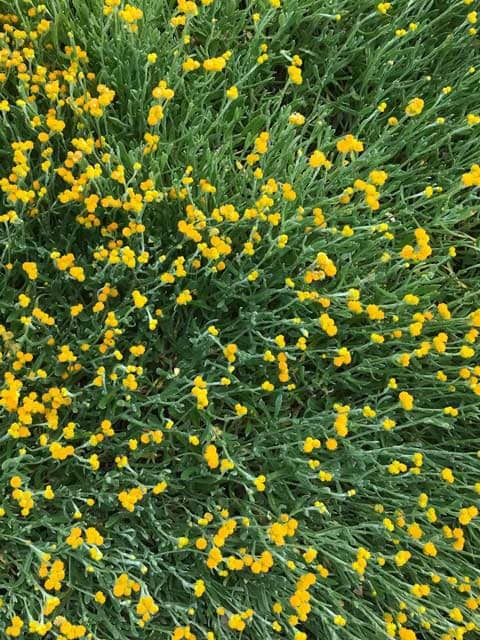
Yellow buttons: Chrysocephalum apiculatum
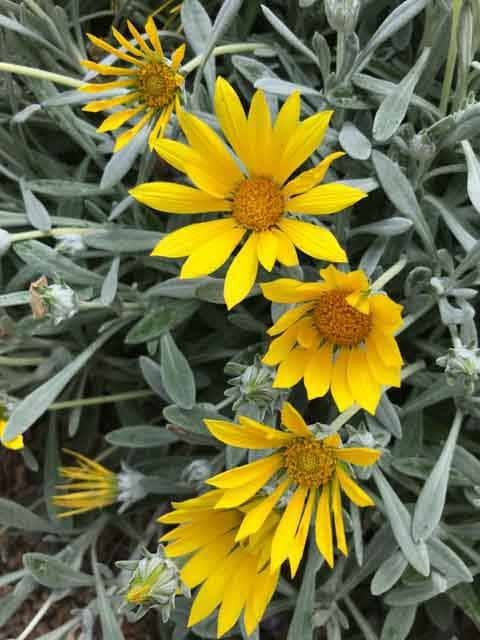
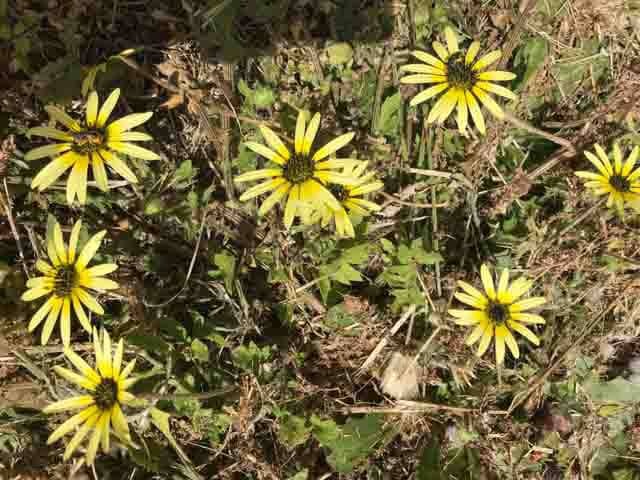
Which plants are responsible for compositae allergy?
The compositae family are plants in which the flower heads are a composite of individual flowers. They are also given the name Asteraceae because the flower heads are star-shaped (aster is Greek for star). These plants include about 20,000 species of flowers, herbs, weeds and vegetables, including asters, daisies, and sunflowers. They occur worldwide, and are found in gardens, roadsides, and the wilderness; they account for about 10% of all flowering plants.
Extracts of compositae are used in topical skin treatments, cosmetics, herbal supplements, natural medicines, and foods.
Common names for some members of the Compositae family |
|||
|---|---|---|---|
Arnica |
Artichoke, globe |
Artichoke, wild |
Bitterweed |
Boneset |
Broomweed |
Burdock |
Capeweed |
Chamomile, Roman |
Chamomile, German |
Champaca of perfumery |
Chickweed |
Chicory |
Chrysanthemum |
Cocklebur |
Cosmos |
Costus of perfumery |
Cotton thistle |
Dandelion |
Echinacea |
Encelia |
Endive |
Elecampane |
Feverfew |
Fireweed |
Fleabane |
Gayule |
Goldenrod |
Hampweed |
Helianthus |
Hogweed |
Ironweed |
Laurel oil |
Leafcup |
Lettuce |
Liverwort |
Marguerite |
Marigold |
Marsh elder |
Mugwort |
Oxeye |
Parthenium |
Pyrethrum |
Ragweed |
Ragwort |
Sagebrush |
Sneezeweed |
Sow thistle |
Star thistle |
Stinkwort |
Sunflower |
Tansy |
Tulip tree |
Whitewood of commerce |
Wormwood |
Yarrow |
How is compositae allergy diagnosed?
Compositae allergy is diagnosed by patch tests performed on a patient with contact allergic dermatitis. The Baseline series of patch test allergens usually contains sesquiterpene lactone mix (alantolactone, dehydroxosus lactone, costunolide), and may also contain compositae mix.
Related plant allergens include parthenolide and specific extracts prepared from individual plants such as dandelion, tansy, yarrow, feverfew, chamomile, arnica and chrysanthemum. It may be necessary to test several of these allergens to confirm compositae allergy. In one study, sesquiterpene mix detected 65% and compositae mix detected 87% of compositae-allergic patients, but individual plant extracts were necessary to confirm the diagnosis in all patients. Parthenolide detects 75% of sesquiterpene lactone allergic patients.
Once someone has become allergic to one of the responsible allergens, their immune system is likely to react to similar chemical structures, resulting in cross-sensitisation and multiple contact allergies. Thus many patients that are patch test positive to one plant extract also test positive to others.
More than one-third of patients with compositae allergy also have an allergy to fragrances, balsam of Peru and rosin (colophony). These are also of plant origin.
Other allergens that may be responsible for compositae dermatitis include monoterpenes (eg, pinene, limonene, terpinene, camphor), coumarin, a sesquiterpene alcohol and thiophene.
Positive patch tests to sesquiterpene lactone
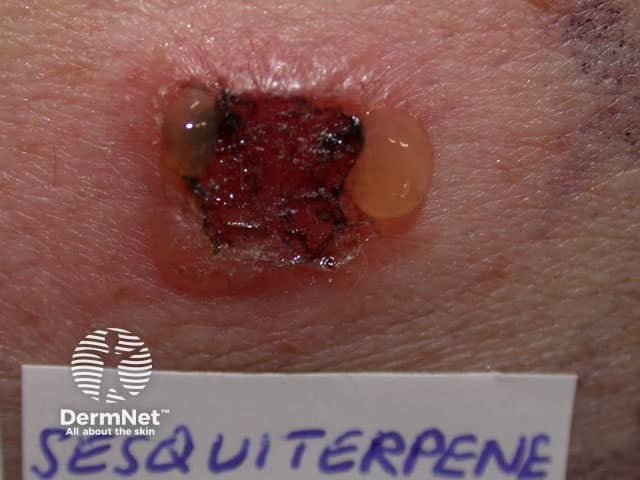
Compositae allergy: positive patch tests
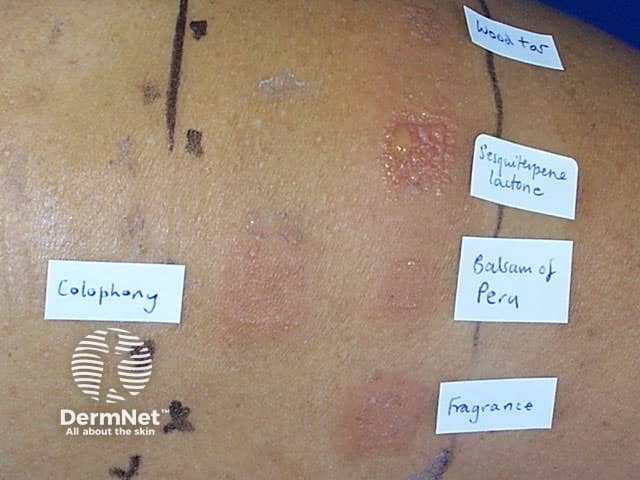
Compositae allergy: positive patch tests
What does compositae dermatitis look like?
Contact allergy to compositae in gardeners, farmers, forestry workers, or florists, may result in serious occupational dermatitis. It may present in several ways.
Hand dermatitis
Dermatitis may affect the backs of the hands only, and/or the palms, or is sometimes confined to the fingertips (sometimes called pulpitis) depending on which sites are in contact with the responsible plant. Dermatitis may be vesicular (blistering), resembling pompholyx, or result in dry red patches.
Hand dermatitis due to Compositae allergy
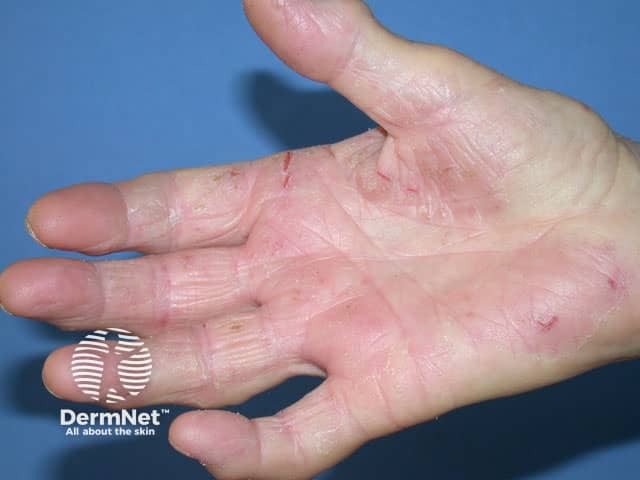
Airborne contact dermatitis
Airborne contact dermatitis affects the face, neck, hands, arms; all areas exposed to plant pollens borne by the wind. It often results in considerable swelling and blistering as well as redness, dryness, or scaling. The rash may vary according to the season, depending on pollen levels.
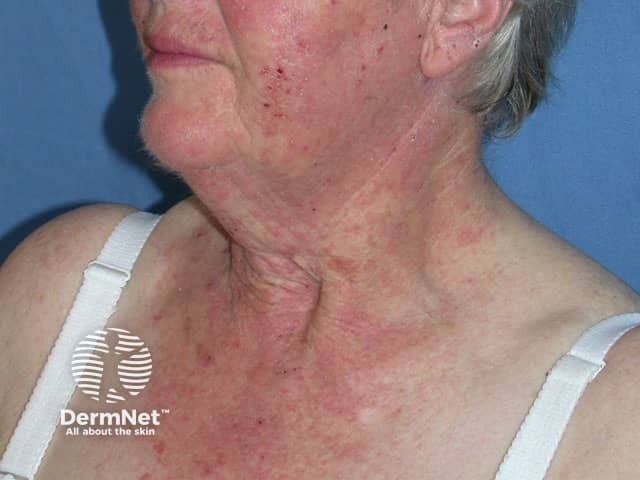
Chrysanthemum allergy
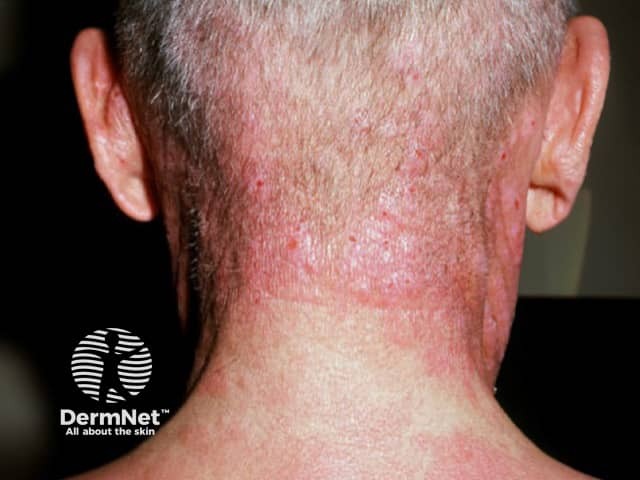
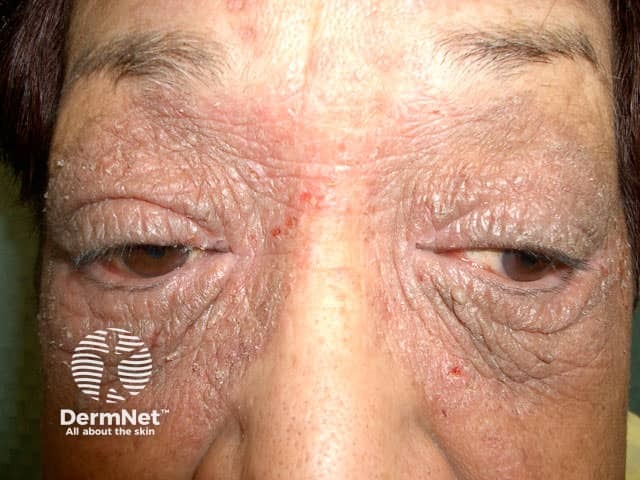
Contact dermatitis to Compositae pollen
Seborrhoeic pattern
In the seborrhoeic pattern of compositae allergy, the dermatitis is most prominent in skin folds such as behind the ears, the sides of the nose, eyelids, and neck. It is possible that pollen sticks to moist areas of skin causing more active dermatitis in these sites. The allergen may be transmitted to these sites via the fingertips.
Erythroderma
When allergy is severe, the rash may spread to apparently unexposed sites. This may present as erythroderma, a serious condition involving the entire skin surface.
Chronic photosensitivity dermatitis
Patients with chronic actinic dermatitis, or actinic reticuloid, are frequently found to have a contact allergy to compositae on patch testing. They tend to be older men with dermatitis affecting the face, neck, and hands. It is believed that chronic contact allergic dermatitis to compositae slowly evolves to photocontact dermatitis and then to photosensitivity even in the absence of known contact with compositae. These patients are exquisitely sensitive to ultraviolet radiation so that dermatitis appears on skin exposed to sunlight for just a few minutes.
It is thought that about 20–75% of patients with compositae dermatitis have some degree of photosensitivity.
Nodular prurigo
Itchy lumps similar to those arising in prurigo nodularis have been the result of contact dermatitis to parthenium in some cases.
Stomatitis
If the leaves of the plant are chewed, the lips, tongue, and mouth may become inflamed and mouth ulcers may occur.
Allergic systemic contact dermatitis
Generalised systemic contact dermatitis may occur if the allergen is ingested (eg, drunk as a tea) and may affect oral mucosa and anus, as well as the skin. It may be intensely itchy. The rash appears after several hours, reaching a peak two or three days after exposure to the allergen.
A nonspecific itchy red dry rash has also been reported to arise following inhalation of pollen.
What is the treatment of compositae dermatitis?
Compositae allergy usually persists lifelong, but dermatitis should clear once the skin is no longer exposed to the plants that are responsible for it. It is therefore very important to find out which plants in the neighbourhood are in the Asteraceae family so that contact with them can be avoided. Cosmetics and creams containing compositae products should not be used. However, most affected individuals may safely eat vegetables of the compositae family.
Exquisitely sensitive patients may need to dress up fully to protect their skin from airborne pollens when outdoors during the pollen season. Wear long gloves when gardening.
Symptomatic treatment depends on the severity, extent and duration of dermatitis and may include:
References
- Compositae Pollen – HON Allergy GLossary
- Compositae dermatitis – PubMed RSS feed
On DermNet
Other websites
- Botanical Dermatology – emedicine dermatology
- Botanical dermatological database (BODD)
